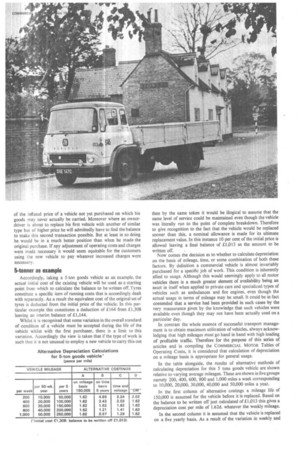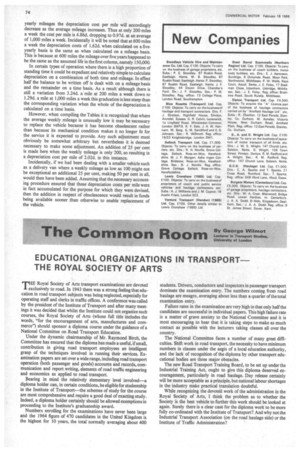Vehicle Replacement
Page 74

Page 75

Page 76

If you've noticed an error in this article please click here to report it so we can fix it.
ATHOUGH it has been established practice for over 50 years in this journal to segregate the total cost of operating a commercial vehicle into ten items they nevertheless still remain interrelated. Particularly does this apply to the two items of maintenance and depreciation. Because of wide and unfortunately exaggerated publicity given to the poor mechanical condition of a small proportion of commercial vehicles in recent months the whole subject of maintenance and official action being taken to raise the overall standard has become of major and urgent concern to all operators.
In recent weeks in this series the relationship between maintenance and depreciation and aspects arising from calculating depreciation have been examined. It has been pointed out that the term "maintenance" has to be accepted in a practical sense as otherwise it could be construed to imply that a vehicle was in fact being maintained in its original condition. This in fact is not the case and, despite maintenance, the vehicle has still ultimately to be replaced if the transport service it is at present providing is to continue.
Whilst this is virtually self-evident to operators it does establish the fact that varying standards of condition of a vehicle are accepted by all operators even though all statutory requirements may have been complied with throughout the life of the vehicle. It is necessary to establish this and the fact that some margin of "insurance" in the mechanical condition of a vehicle is essential if a reliable service is to be provided free from breakdown and consequent failure to deliver on time.
Because road transport is substantially dependent upon flexibility for its continued success it follows that there can be infinite variation in the operating conditions and likewise the length of service a vehicle can reasonably be expected to provide.
Additionally when making an estimate of such length of service regard has to be paid not only to operating conditions and type of vehicle but also the level of maintenance facilities not only available now but likely to be available throughout that period.
Closely associated with the level of maintenance facilities will be the availability of spares and replacement units relative to the make and type of vehicle under consideration. Most important of all, however, particularly as the Industrial Training Act takes effect throughout the whole field of trade and industry will be the availability of competent labour irrespective of whether the maintenance is undertaken by the operator himself or the work is contracted out to a local garage.
Written off
Having made due allowance for the associated factors just mentioned an estimate has to be made as to the amount to be written off as depreciation and the manner in which depreciation should be calculated so that it can conveniently be included in the total cost of operation.
Dealing first with the amount to be written off, I propose here to base this on the actual cost of the vehicle being operated although admittedly there is a school of thought which contends that in this era of inflation any such method of calculating depreciation would inevitably fall short of providing sufficient funds to replace the existing vehicle with one of a similar type.
Where, however, operating costs form the basis of charges actually made to the customer it could be contended that it would be unreasonable to include in the charge of a current customer part of the inflated price of a vehicle not yet purchased on which his goods may never actually be carried. Moreover where an ownerdriver is about to replace his first vehicle with another of similar type but of higher price he will admittedly have to find the balance to make this second transaction possible. But at least in so doing he would be in a much better position than when he made the original purchase. If apy adjustment of operating costs and charges were made necessary it would seem equitable for the customers using the new vehicle to pay whatever increased charges were necessary.
5-tonner as example Accordingly, taking a 5-ton goods vehicle as an example, the actual initial cost of the existing vehicle will be used as a starting point from which to calculate the balance to be written off. Tyres constitute a specific item of running costs that is accordingly dealt with separately. As a result the equivalent cost of the original set of tyres is deducted from the initial price of the vehicle. In this particular example this constitutes a deduction of £164 from £1,308 leaving an interim balance of £1,144.
Whilst it is recognized that some variation in the overall standard of condition of a vehicle must be accepted during the life of the vehicle whilst with the first purchaser, there is a limit to this variation. Accordingly the view is taken that if the type of work is such that it is not unusual to employ a new vehicle to carry this out then by the same token it would be illogical to assume that the same level of service could be maintained even though the vehicle was literally run to the point of complete breakdown. Therefore to give recognition to the fact that the vehicle would be replaced sooner than this, a nominal allowance is made for its ultimate replacement value. In this instance 10 per cent of the initial price is allowed leaving a final balance of £1,013 as the amount to be written off'.
Now comes the decision as to whether to calculate depreciation on the basis of mileage, time, or some combination of both these factors. By definition a commercial vehicle is almost invariably purchased for a specific job of work. This condition is inherently allied to usage. Although this would seemingly apply to all motor vehicles there is a much greater element of availability being an asset in itself when applied to private cars and specialized types of vehicles such as ambulances and fire engines, even though the actual usage in terms of mileage may be small. It could be in fact contended that a service had been provided in such cases by the very reassurance given by the knowledge that such vehicles were available even though they may not have been actually used on a particular day.
In contrast the whole essence of successful transport management is to obtain maximum utilization of vehicles, always acknowledging that high mileages must go hand in hand with high loading of profitable traffic. Therefore for the purpose of this series of articles and in compiling the COMMERCIAL MOTOR Tables of Operating Costs, it is considered that calculation of depreciation on a mileage basis is appropriate for general usage.
In the table alongside, the results of alternative methods of calculating depreciation for this 5 tons goods vehicle are shown relative to varying average mileages. These are shown in five groups namely 200, 400, 600, 800 and 1,000 miles a week corresponding to 10,000, 20,000, 30,000, 40.000 and 50.000 miles a year.
In the first column of alternative costings a mileage life of 150,000 is assumed for the vehicle before it is replaced. Based on the balance to be written off just calculated of £1,013 this gives a depreciation cost per mile of 1.62d. whatever the weekly mileage.
In the second column it is assumed that the vehicle is replaced on a five yearly basis. As a result of the variation in weekly and yearly mileages the depreciation cost per mile will accordingly decrease as the average mileage increases. Thus at only 200 miles a week the cost per mile is 4.86d. dropping to 0.97d. at an average of 1,000 miles a week. Incidentally it will be noted that at 600 miles a week the depreciation costs of 1.62d. when calculated on a fiveyearly basis is the same as when calculated on a mileage basis. This is because at 600 miles the mileage over five years happened to be the same as the assumed life in the first column, namely 150,000.
In certain types of operation where there is a high proportion of standing time it could be expedient and relatively simple to calculate depreciation on a combination of both time and mileage. In effect half the balance to be written off is dealt with on a mileage basis and the remainder on a time basis. As a result although there is still a variation from 3.24d. a mile at 200 miles a week down to 1.29d. a mile at 1,000 miles a week this graduation is less steep than the corresponding variation when the whole of the depreciation is calculated on a time basis.
However, when compiling the Tables it is recognized that where the average weekly .mileage is unusually low it may be necessary to replace the vehicle because it has become obsolescent rather than because its mechanical condition makes it no longer fit for the service it is expected to provide. Any such adjustment must obviously be somewhat arbitrary but nevertheless it is deemed necessary to make some adjustment. An addition of 25 per cent is made here when the weekly mileage is only 200. so resulting in a depreciation cost per mile of 2.02d. in this instance.
Incidentally, if we had been dealing with a smaller vehicle such as a delivery van where a weekly mileage as low as 100 might not be exceptional an additional 25 per cent, making 50 per cent in all, would then have been added. Assuming that the necessary accounting procedure ensured that these depreciation costs per mile were in fact accumulated for the purpose for which they were devised, then the addition in respect of obsolescence would result in funds being available sooner than otherwise to enable replacement of the vehicle.




















































































































